2.1 INTRODUCTION
Suresh rubs two stones together. He is surprised to see sparks being generated. He wonders how?
Sparks are generated because of the heat produced on striking the two stones together. Heat is produced due to the action of a force known as the force of friction, which exists between the two stones when rubbed against each other. An oscillating pendulum stops after some time. Why is it so? It happens due to the friction offered by air to the bob of the pendulum. It reduces the speed of the bob, and eventually makes it stop after sometime.
Take a book and push it on the table. What do you observe?
You will find that the book stops moving, after travelling a small distance. Why does this happen? Is there any force involved here?
Without the application of force, a body cannot undergo a change in its state of motion. The force involved in the given example is the force of friction. It always acts in the opposite direction of motion. In the above example, when the book is pushed towards the right, friction acts in the left direction. Similarly, when a ball or bicycle moves forward, friction acts in the backward direction and tries to oppose the forward motion.
An important property of friction is that it always acts in the direction opposite to the direction of motion i.e. if an object is moving from left to right, the frictional force acts on it from right to left and vice versa.
A car moving from right to left stops when brakes are applied. It happens due to the frictional force, which acts in between the road and tyres of the car. Can you determine the direction of this force? The force of friction acts between two surfaces when they come in contact with each other.
We are able to walk because of the force of friction, which exists between our feet and the ground. When we walk, we press the ground in the backward direction, using our feet. Since friction acts in the opposite direction of motion, it pushes us forward. Hence, we are able to walk.
2.2 FRICTION
When an object is in contact with a surface, there is a force acting on the object. One component of this force that is perpendicular to the surface, is called the normal force (or) normal reaction.
Let us consider a block on a horizontal table surface.
The weight of the block acts in the downward direction towards the earth. How is the table able to hold the block? There may be a force helping the table to hold the block which is equal to weight of the block.
This force is perpendicular to the surface of the table and known as Normal Reaction or simply Normal.
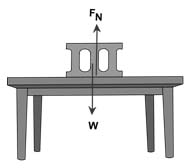
It is in the upward direction and is denoted by (or) R (or) N.
Normal reaction
The outward force acting perpendicular to the surface of a body is known as its normal reaction.
This normal reaction is equal to the weight of the body i.e. R = W = mg
i.e. R = W = mg
R m ( g is constant)
i.e. more is the mass, more is the normal reaction and less is the mass, less is the normal reaction.
If more than two blocks are placed one over the other on a horizontal ground then normal reaction between two blocks will be equal to the weight of the blocks over the common surface.

For example
= Normal reaction between A and B =
= Normal reaction between B and C = and so on.
When the object moves (or) attempts to move along the surface, there is also a component of the force that is parallel to the surface.
This parallel force component is called the frictional force (or) simply friction.
Definition
Friction is the force which opposes relative motion between two bodies in contact and acts tangentially along the surfaces of the contact.
Force of friction always acts in a direction opposite to the motion of the object.
2.3 ORIGIN OF FRICTION
When two bodies are in contact, their relative motion is opposed by a resistance called friction.
Surfaces that appear to be highly polished can actually look quite rough when examined under a microscope.
Such an examination reveals that two surfaces in contact touch only at relatively few spots known as microscopic contact points as shown in the figure.
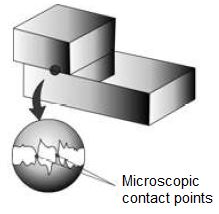
The microscopic area of contact for these spots is substantially less than the apparent macroscopic area of contact between the surfaces perhaps thousands of time less.
Even when two highly polished surfaces are in contact, they touch only at relatively few points.
At these contact points the molecules of the different bodies are close enough together to exert strong attractive intermolecular forces on one another.
2.4 FACTORS AFFECTION FRICTION
I. Materials of the bodies in contact
Push a wooden block on the surface of wood and glass.
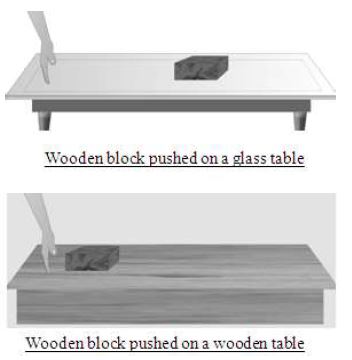
We observe that the friction is less between wood and glass when compared between wood and wood.
Reason
Force of adhesion is more between wood and wood when compared to glass and wood.
Friction between two bodies depends on the material of the bodies in contact.
II. Roughness of surfaces in contact
Roll a ball along a Rough cement floor & Smooth cement floor.
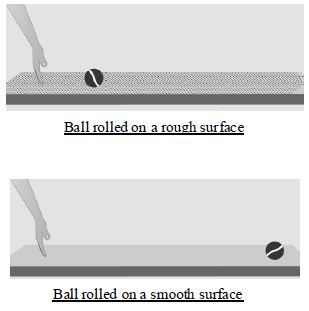
We observe that the ball rolls less distance before coming to rest on the rough surface.
But the ball rolls more distance before coming to rest on the smooth surface.
Reason
Friction is less on the smooth cement floor than on the rough cement floor.
Friction depends on the roughness of the surfaces in contact.
III. Normal reaction
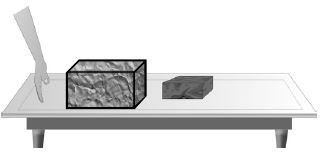
Try to move the blocks on the table.
Which is more difficult to move?
It is difficult to move heaver block.
Reason
More is the weight of the body, more is the normal reaction, more is frictional force.
Frictional force increases directly with normal reaction.
IV. Temperature and impurities
Friction depends on the temperature and impurities present between the two surfaces.
Note: Friction is independent of the area of contact between the two surfaces, as long as normal reaction is same.
Factors affecting friction – Summary
1. Materials of the bodies in contact: If the force of adhesion is more, then friction is more.
2. The roughness of surfaces in contact: If the surface is rough then friction is more.
3. Normal reaction: If the normal reaction is more, then friction will be more.
4. Temperature sand impurities: Friction depends on the temperature and impurities present between the two surfaces.
2.5 MATHEMATICAL FORMULA OF FRICTION
We know that, more is the weight of the body, more is the normal reaction, more is the frictional force.
Frictional force is directly proportional to the normal reaction.
Friction (f) Normal reaction (R)
F R
F = R where is a constant called ‘coefficient of friction’.
2.6 STATIC FRICTION
Consider a block which is initially at rest on a table. As long as there is no attempt to move, the block, there is no frictional force.
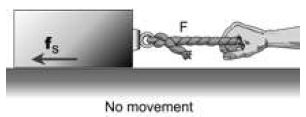
Then, a horizontal force ‘F’ is applied to the block by means of a rope.
If “F” is small, as in figure experience tells us that the block still does not move. Why?
It does not move because a frictional force called static frictional force exactly cancels the effect of the applied force.
The direction of is opposite to that of F, and the magnitude of fs equals the magnitude of applied force, fs = F .
The force of friction which exactly counter balance the applied force during the stationary state of a body is called static friction.
Increasing the applied force by a small amount still does not cause the block to move.
There is no movement because the static frictional force also increases by an amount that cancels out the increase in the applied force.
This is explained in the figure.
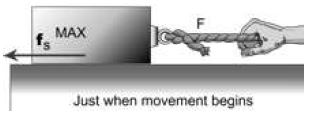
If the applied force continues to increase, however, there comes a point when the block finally begins to slide.
The force just before the block moves represents the maximum static frictional force fsMAX that the table can exert on the block.
This is explained in figure.

Any applied force that is greater than fsMAX cannot be balanced by static friction and the resulting net force accelerates the block to the right.
From the above discussion, we can say that static friction (fs) adjust itself according to the applied force ‘F’.
Thus static friction has “self – adjusting” property.
When the applied force (F) increases gradually, static friction (fs) too increase to a maximum limit.
The maximum limit of static friction is known as limiting friction.
The maximum value of static frictional force which comes into play when a body is just going to start sliding over the surface of another body is called limiting force of friction.
The theory of static and kinetic friction can be better understood by the following simple example.
Suppose a block of mass 1 kg placed over a rough surface and a horizontal force F is applied on the block as shown in figure.

Now, let us see what are the values of force of friction f and acceleration of the block a if the force F is gradually increased.
Given that = 0.5, = 0.4 and g = 10 m/s2.
Let’s first calculate the limiting and kinetic frictions
Forces acting on the block using free body diagram are shown below
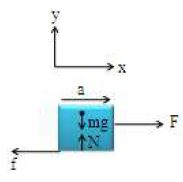
i. Mg downward by the earth (gravity)
ii. N upward by the block M (normal force)
iii. f = N towards left of the block
iv. F is applied force
The equation of motion along y-axis is
N – mg = 0 N = mg
Substituting the values, we get normal reaction,
N = mg = (1 kg ) (10 m/s2) = 10 N
Limiting friction = N = (0.5) (10) = 5 N
kinetic friction = N = (0.4) (10) = 4 N
Therefore the values of limiting friction = 5 N and kinetic friction = 4 N.
The following tabular form shows how the force of friction f depends on the applied force F for the above example.
Let’s see how the force of friction f depends on the applied force F.
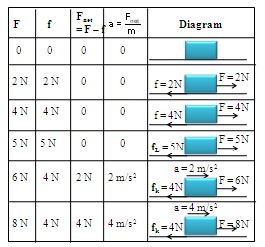
A graph is plotted between force of friction and applied force taking force of friction on Y – axis and applied force on X – axis.
The graph is as follows.
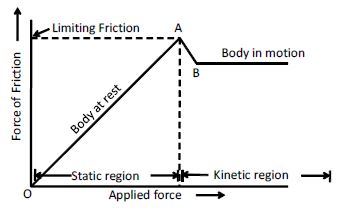
As the applied force is increased, the force of friction increases from O to A. The force of friction is maximum at point B, when the body just tends to move. So, point A shows the limiting static friction. When the body starts moving slowly or sliding, then the friction decreases from A to B and remains constant.
Finding the Direction of Static Friction
The direction of static friction on a body is such that the total force acting on it keeps it at rest with respect to the body in contact.
Newton’s first or second law can often be used to find the direction of static friction.
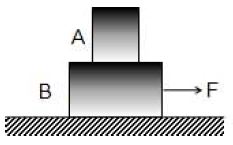
The figure shows a block A placed on another block B which is placed on a horizontal table. The block B is pulled by a force F towards right. Suppose the force is small and the blocks do not move. Let us focus our attention on the upper block. The upper block is at rest with respect to the ground which is assumed to be at rest. Thus, the resultant force on the upper block is zero (Newton’s first law). As no other external force acts on the upper block the friction acting on the upper block due to the lower block must be zero.
If the force F is increased, the two blocks move together towards right with some acceleration.
As the upper block accelerates towards right the resultant force on it must be towards right. As friction is the only horizontal force on the upper block it must be towards right. Notice that it is the friction on the upper block which accelerates it towards right.
It is a general misconception that friction always opposes the motion. It is not really true. In many cases friction causes the motion. A vehicle accelerates on the road only because the frictional force on the vehicle due to the road drives it. It is not possible to accelerate a vehicle on a frictionless road. Friction opposes the relative motion between the bodies in contact.
Do you know?
Though friction opposes motion, yet in certain cases, friction is also the cause of motion. For example.
1. When a person pushes the ground backwards (action), the rough surface of ground reacts and exerts a forward force due to friction–which causes the motion. Without friction, person would slip and shall not be able to move.
2. In cycling, rear wheel moves by the force communicated to it by pedaling, while front wheel moves by itself.
Therefore, like in walking, force of friction on rear wheel is in the forward direction. As front wheel moves by itself, force of friction on front wheel is in the backward direction.
However, when pedaling is stopped, both the wheels move by themselves. So the force of friction on both the wheels is in the backward direction.
Thus without friction, motion cannot be started, stopped or transferred from one body to the other.
Characteristics of static friction
Static frictional force between a pair of surfaces has two characteristics.
1. It is independent of the macroscopic area of contact between the objects.
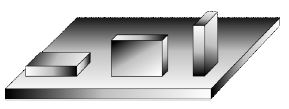
In figure the maximum static frictional force that the surface of the table can exert on a block is the same, whether the block is resting on its largest or its smallest side.
2. Magnitude of maximum static friction fsMAX is proportional to the magnitude of the normal force R.
Magnitude of normal force R indicates how hard two surfaces are being pressed together.
The harder they are pressed, the larger is fsMAX
Because the number of microscopic contact points is increased.
Therefore we can say fsMAX R
Expression for static friction
Static frictional force is directly proportional to normal force (R) i.e., fsMAXR (or) fsMAX = R
Where is called co-efficient of static friction.
The magnitude fs of the static frictional force can have any value from zero upto a maximum value of fsMAX depending on the applied force.
In other words, fs fsMAX
The equality, fsMAX = R holds only when fs attains its maximum value. The co-efficient of static friction, being the ratio of magnitudes of two forces.
i.e., Where is force of friction, R is reaction force . Therefore is a unit less number.
It depends on the type of material from which each surface is made.
2.7 SLIDING FRICTION
Let’s understand from the following activity.
A wooden block is placed on a glass surface. If force applied on the block then the wooden block does not rolls but slides over the glass surface. After the block just starts sliding over the surface, we require a force to maintain the motion of the body. The required force is maintained by a frictional force.
This kind of frictional force, is called “sliding or kinetic or dynamic frictional force” which tries to bring the block to rest.
Force of friction which comes into play when a body slides on an another surface is called sliding friction or kinetic friction.
It is denoted with ‘’.
Dynamic friction is numerically equal to the force required to keep the body to slide over another body with uniform motion.
Measurement of Sliding friction
We know that, Frictional force (f) is measured by using mathematical relation: f = R where ‘ ’ is coefficient of friction and R is normal reaction.
Similarly, the sliding friction () is measured by . where ‘’ is coefficient of Sliding friction.
R is normal reaction.
2.8 ROLLING FRICTION
The frictional force that exists between the two surfaces when a body rolls over the other surface is called rolling friction. It is denoted by .
Explanation
To understand the rolling friction (fr) consider a lawn roller moving on the ground.
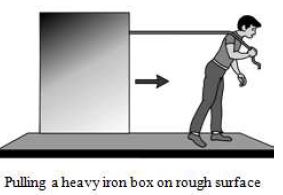
As the roller rolls along the ground a friction exists between the roller and the ground. This is known as rolling friction ().
It is quite difficult to pull a heavy iron box on a rough floor.
However, if the box is provided with four wheels, also made of iron, it becomes easier to move the box on the same floor.
The wheel does not slide on the floor rather it rolls on the floor. The surfaces at contact do not rub each other.
The velocity of the point of contact of the wheel with respect to the floor remains zero all the time although the centre of the wheel moves forward.
The friction in the case of rolling is quite small as compared to kinetic friction.
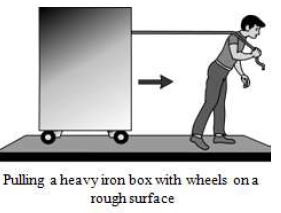
Quite often the rolling friction is negligible in comparison to the static or kinetic friction which may be present simultaneously.
To reduce the wear and tear and energy loss against friction, small steel balls are kept between the rotating parts of machines which are known as ball bearings.
By using ball bearings. As shown in Figure, the ball bearings arrangement consists of two co-axial cylinders A and C, between which suitable number of hard steel balls B are arranged.
The inner cylinder A is fitted on the axle and outer cylinder C is fixed to the wheel.
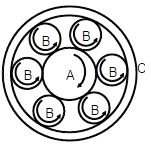
When the wheel B rotates, the balls rotate in the direction shown in the above figure. The wheel thus rolls on the balls instead of sliding on the axle. In this way, sliding friction is converted into rolling friction which is much less. Ball bearings are commonly used in bicycles etc.
Mathematical expression for Rolling friction
We know that, friction (f) is measured by using mathematical relation ; f = R where ‘ ’ is coefficient of friction and ‘R’ is normal reaction. ; where is the coefficient of rolling friction.
2.9 COMPARISON BETWEEN COEFFICIENTS OF FRICTION
The force of kinetic friction () is always less than the force of limiting or static friction ()
i.e,
___________ (1)
We know that it is much easier to roll an object on a surface, than to slide it. So, rolling friction is much is much less than the sliding friction. i.e.,
___________ (2)
From the above equation (1) and (2), we can make a comparison between the three kinds of coefficient of frictions.
As
Value of
Whatever may be the nature of two surfaces and whichever may be the condition, the value of coefficient of friction of surface never exceeds unity (or one).
It is always less than or equal to one i.e.,
2.10 FRICTION IN FLUIDS
So, you see that air opposes motion through it. Not only air, all gases and liquids oppose motion through them.
• In science, liquids and gases are collectively referred to as fluids. This is because these substances have a tendency ‘to flow’.
The frictional force exerted by fluids is also known as ‘drag’.
• Like solids, fluids (all liquids and gases) also exert frictional force on objects that pass through them.
The frictional force experienced by a body moving through a fluid depends on a number of factors. For better understanding of these factors, let us see an animation.
What have you heard? Streamlined shape? What is that?
A body moving in a fluid (liquid or air) has to overcome fluid friction (drag). This results in the loss of energy. Since drag depends on the shape of an object, it can be minimized by giving objects a special shape. For example, cars and aircrafts are designed in such a way that fluids can pass through them smoothly. For that purpose, they are given a streamlined body.
In a ship, the part which is above the water experiences the force of friction from air and the part which is inside the water experiences the force of friction from water. Hence, these parts have been given a unique shape to overcome the force of friction by both fluids.
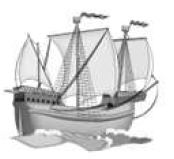
Formula 1 (also referred to as F1) is the fastest motor car race in the world. The shape of a formula one car is designed in such a way that it helps in reducing the air drag and allows it to achieve an average speed of 360 km/hr!
2.11.ADVANTAGES OF FRICTION
1. Enable to Walk
We are able to walk because of friction. You must have observed that it is very difficult to walk on an oily surface. This is because on an oily surface, friction between our feet and the ground becomes so less that we cannot move forward.
2. To stop vehicles
Due to friction between the tyres and the ground, we are able to drive automobiles. Without friction, it would be impossible to stop our vehicle after starting.
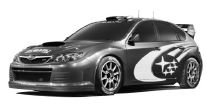
3. For the sticking of two bodies
Now two bodies will stick to each other, if there is no friction between the surfaces.
4. To hold the objects
To hold a glass of water, friction is necessary. Due to friction present between our fingers and the outer surface of the glass, we are able to grip the glass of water. If there was no friction present, it would not be possible to hold it. It is impossible to hold any object like pencil, rod, book, cell phone etc, if there is no force of friction between our fingers and the objects.
5. Lightning a match stick
Lighting a match stick is possible due to the friction between the matchstick and its cover. When we strike a match stick against its cover, fire is produced because of friction. Likewise, when we rub two stones against each other, friction between them produces fire.
6. Fixing a nail
A nail can be fixed in a wooden plank because of friction. Without friction, the wooden plank will not be able to hold the nail, when it is pushed on its surface.
7. Playing a violin
Friction is required to play the violin, or to move a mouse on the mouse pad. If there was no friction between the bow and strings of violin, no music would have ever been produced.
8. To drive a pulley
A pulley cannot be driven by a belt unless there is friction between the pulley and the belt.
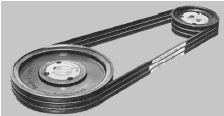
9. To avoid slipping
Sand is spread on wet ground to increase friction and to avoid slipping. The wheels of a railway engine are rotating and moving forward, due to friction only. If there is no friction, the wheels will only rotates, without moving forward.

10. To warm up ourselves
In order to warm up ourselves, we require heat. In the absence of any combustible substance nearby, simply rub our palms to produce heat.
11. Automobile tyres made rough
The surface of automobile tyre is made rough, so as to provide a firm grip between the tyres and the road. And also help against skidding.
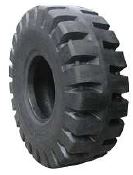
It also provides the necessary reaction of the ground, which helps the wheel, move in forward direction.
2.12.DISADVANTAGES OF FRICTION
1. Friction in machines produces heat and undesirable noise. This heat and sound produced cannot be used to do any work and these forms of energy is lost. Thus, there is loss of energy due to friction.
2. Machines wear out and need lubrication after a period of time due to the friction present between the different parts of a machine.
3. Friction reduces the output produced by the machines. To overcome excess friction in air, a lot of fuel is wasted in cars and airplanes. Therefore, cars and airplanes are streamlined and given a unique shape to reduce friction.
4. Tyres or soles of our shoes wear out because of friction. For this reason, we need to change our shoes after a period of time.
5. The force of friction between air and moving vehicles like buses, cars, trains, airplanes, rockets etc. decreases their speed. To get rid of the disadvantages of friction we need to overcome and control it.
2.13.METHODS TO INCREASE FRICTION
Although friction is considered as a necessary evil, in many cases we need friction to perform various tasks. Some of these cases are discussed below:
1. By making surfaces rough Rough surfaces have better grip on each other.
a. Hence the sole of shoes is made rough in order to increase grip on surface.
b. Grooves are made in tyres of vehicle, to increase their grip on road.
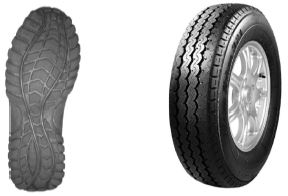
2. By using dry surfaces
When road gets wet, we skid on the road, because of less friction. On the same road, when it is dried we can walk on it without skidding. Thus, dry surfaces have more friction that the wet surfaces. When the surface is wet, irregularities on the road are filled by water, to friction decreases.
3. By increasing the weight
We know that, friction is directly proportional to weight of the body. By increasing weight of a body, the normal reaction increases. The increase in normal reaction increases the friction between the given two surfaces. Thus, increasing the weight of a body increases the friction.
4. Other methods
i. In grinder (silbatta), small holes are made to increase friction.
ii. Before weightlifting, a weight lifter rubs powder on his hands. Do you know why? This is because it helps him in acquiring a better grip to hold the load.
iii. Stripes are made on the surface of a tyre to provide a better grip on the road.
2.14. METHODS TO CONTROL OF FRICTION
1. Use of lubricants
The material which is used to reduce friction is known as lubricant. By using lubricants in machinery parts, friction can be reduced.
Examples
a. We use oil or grease on the surfaces of machinery parts to reduce friction.
b. Talcum power is used as a lubricant to reduce friction between caroms and carom board.
When power is sprinkled, clearly shows difference that friction is reduced.
When windows and doors become jammed, we apply grease or oil to their joints to make them move freely again. Similarly, to prevent the wear and tear of machine parts, we apply grease between the moving parts of a machine.
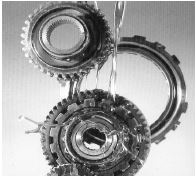
Substances such as oil, grease and graphite used in lubrication are known as lubricants.
In a game of carom, powder is sprinkled on the board. Can you explain the reason behind this?
When you apply soap on your hands, does it become easier to rub your hands against each other? Is this an example of lubrication?
Although friction can be minimized by the action of lubricants, one can never make friction equal to zero. This is because irregularities are always present on the surface. An excess of lubricants may also result in fluid friction.
2. Use of ball bearings
In rotating machines like wheels of bicycles, motor cycles etc., ball bearings are used to reduce friction between the inner fixed part called axle and outer rotating part called hub.
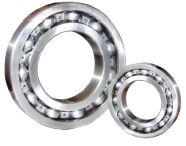
While the hub rotates around the axles, it makes the ball bearings, which are in contact both with hub and axle; rotate and thus friction is reduced.
3. Polishing surfaces
By polishing, a surface can be made smooth. Hence, roughness of the surface is decreased. This decreases the friction.
4. Changing shape of the objects
Friction can be reduced by giving a definite shape to an object. Aeroplanes are given a typical shape to reduce friction due to air. Cars also use this method to improve efficiency.









